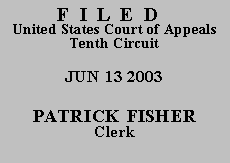

| UNITED STATES OF AMERICA, |
|
| v. | |
| BRYANE C. MENDENHALL aka Christopher Bryane Mendenhall, |
The narrow issue presented in this appeal is whether the district court erred in finding that Defendant's prior convictions for burglary and for possession of cocaine with intent to sell were unrelated. Prior felony convictions for a crime of violence or a controlled-substance offense whose sentences "are counted separately under the provisions of § 4A1.1(a), (b), or (c)" may be used for career-offender enhancement. USSG § 4B1.2(c)(2). "Prior sentences imposed in unrelated cases are to be counted separately." USSG § 4A1.2(a)(2). But "[p]rior sentences imposed in related cases are to be treated as one sentence for purposes of § 4A1.1(a), (b), and (c)." Id. To determine whether prior sentences are related, application note 3 to § 4A1.2 instructs:
Prior sentences are not considered related if they were for offenses that were separated by an intervening arrest (i.e., the defendant is arrested for the first offense prior to committing the second offense). Otherwise, prior sentences are considered related if they resulted from offenses that (A) occurred on the same occasion, (B) were part of a single common scheme or plan, or (C) were consolidated for trial or sentencing.
Id. § 4A1.2, comment. (n.3).
It is undisputed that Defendant's prior offenses for burglary and for possession of cocaine with intent to sell were not separated by an intervening arrest, and Defendant does not contend that the offenses occurred on the same occasion or were consolidated for trial or sentencing. Instead, he argues that the offenses are related because they "were part of a single common scheme or plan." The district court rejected this argument and so do we.
Although "[t]he meaning of the word 'related' is a legal issue that we review de novo," we "review the district court's factual determination that the cases were unrelated under a clearly erroneous standard." United States v. Gary, 999 F.2d 474, 479 (10th Cir. 1993). "[I]n considering whether prior convictions arose from a common scheme or plan, the focus should be on 'factual commonality.'" United States v. Wiseman, 172 F.3d 1196, 1219 (10th Cir. 1999) (quoting United States v. Shewmaker, 936 F.2d 1124, 1129 (10th Cir. 1991)). "Factors such as temporal and geographical proximity as well as common victims and a common criminal investigation are dispositive." Shewmaker, 936 F.2d at 1129.
None of these factors is present with respect to Defendant's prior offenses. There is neither temporal nor geographic proximity between the crimes, which occurred more than three weeks and approximately 50 miles apart, in different Kansas counties. Cf. United States v. Ciapponi, 77 F.3d 1247, 1252 (10th Cir. 1996) (two drug offenses occurring one week apart not part of single common scheme or plan). The two offenses did not have the same victim. And although Defendant argues that there was a common criminal investigation because "law enforcement officers were searching [Defendant's] residence for drugs [when] they found evidence of the burglary," Aplt's Br. at 9, the document upon which Defendant relies to support this contention indicates that the police found evidence of the burglary during the search due to happenstance, not a common investigation. To the extent that Defendant is arguing that the offenses are related because "the complaints were filed on the same day and one probation revocation hearing was conducted in both cases," id. at 5, he does not explain how these facts are relevant to a determination that the offenses were part of a single common scheme or plan.
Finally, Defendant asserts that the offenses of burglary and possession of cocaine with intent to sell were part of a single common scheme or plan because they were "animated by the same motive"-- "[t]he burglary. . . was committed to obtain money with which to buy drugs for distribution." Id. at 9, 10. The problem with this contention is that it is not supported by the record. Defendant testified that when he committed the burglary at issue, he was "high on drugs," and committed the crime "as a joy thing." R., Vol. III, Doc. 80, at 14. Two days later, after police searched his residence, Defendant decided to take the stolen property from his house to Texas to avoid detection and to sell it in order to purchase drugs. From this testimony, it appears that Defendant did not formulate the plan to sell the stolen property to purchase drugs until some time after he committed the burglary. There is no "single common scheme or plan" under these circumstances. See Wiseman, 172 F.3d at 1219 (no single common scheme or plan among escape and robbery offenses, where "defendant has not even alleged that when he fled the prison in Idaho he was already planning a series of grocery store robberies in several states. To the contrary, in his confession defendant related forming the idea with [a companion] some time after the escape."); cf. United States v. Kinney, 915 F.2d 1471, 1472 (10th Cir. 1990) (three bank robberies over three-month period not related where the "only evidence of a common scheme was defendant's own testimony about [obtaining money to] support[] his drug habit").
Accordingly, we conclude that the district court's finding that Defendant's prior offenses were unrelated was not clearly erroneous. We AFFIRM the judgment of the district court.
ENTERED FOR THE COURT
Harris L Hartz
Circuit Judge
*.After examining the briefs and appellate record, this panel has determined unanimously that oral argument would not materially assist the determination of this appeal. See Fed. R. App. P. 34(a)(2); 10th Cir. R. 34.1(G). The case is therefore ordered submitted without oral argument. This order and judgment is not binding precedent, except under the doctrines of law of the case, res judicata, and collateral estoppel. The court generally disfavors the citation of orders and judgments; nevertheless, an order and judgment may be cited under the terms and conditions of 10th Cir. R. 36.3.